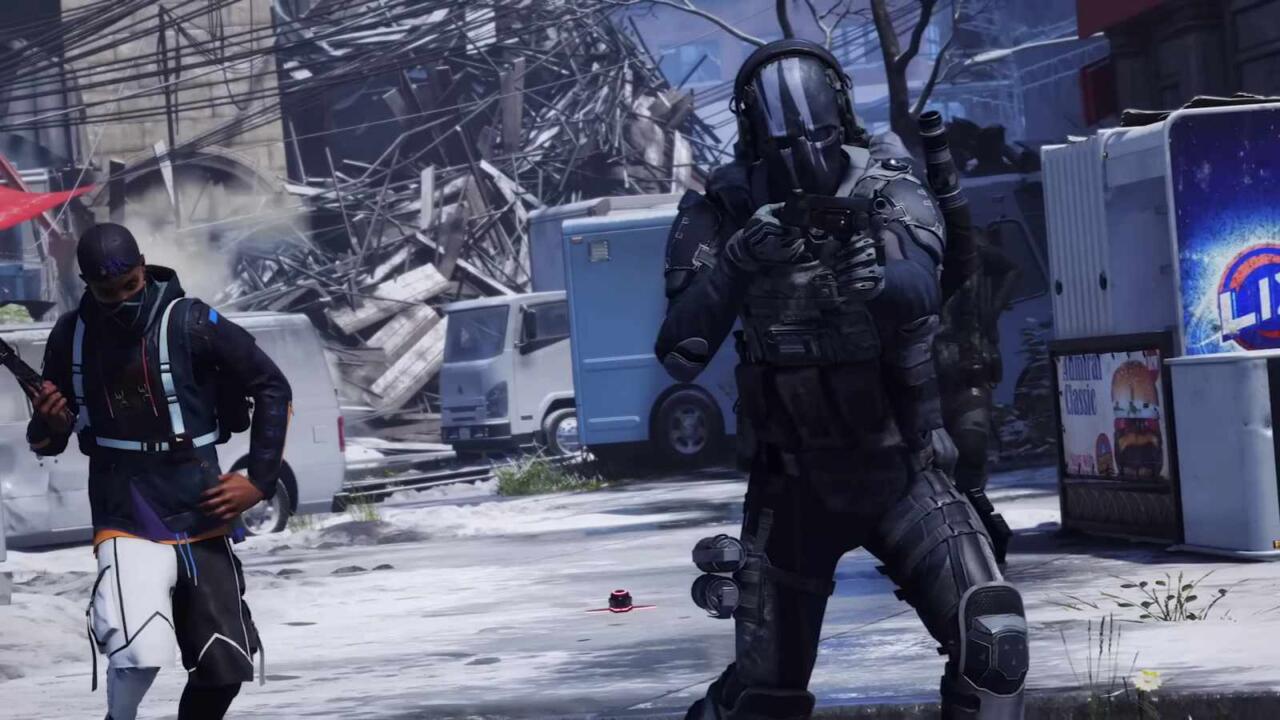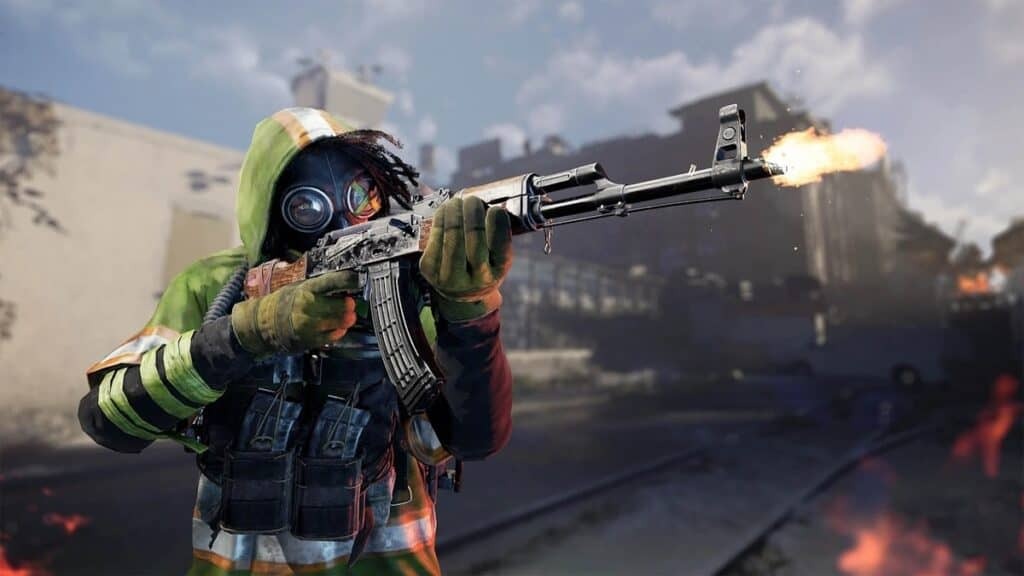XDefiant’s practice zone offers a stark reminder that you are, in fact, playing a Ubisoft game. In one corner of this abandoned convention center, there are arcade machines for Far Cry 3: Blood Dragon, Just Dance 2014, and Riders Republic. Near the front desk, a large screen displays various Assassin’s Creed protagonists striking a pose, while the short corridor leading to the assault course is adorned with a giant Rabbid statue, wide-eyed and mouth agape. All of this gives the impression that XDefiant is a celebration of Ubisoft’s history, but that’s only half true. Instead, it’s a celebration of Ubisoft games that predominantly revolve around shooting guns.
XDefiant feels like an homage, and as such, doesn’t offer anything we haven’t already seen in the competitive shooter space before. It’s a generic free-to-play shooter, mixing ingredients from games like Call of Duty and Overwatch to create an all-too-familiar broth. Being wildly unoriginal isn’t a bad thing if the formula works, and in this case, it does, for the most part. But some of its disparate ideas don’t quite mesh, and this approach isn’t enough to stand out in a crowded shooter market–especially when it delivers such a continuous sense of deja vu.
Each of XDefiant’s recognizable game types pits two teams of six players against one another. The action here is grounded, foregoing much of the fluid traversal present in many modern shooters by limiting your movement options and restricting where you can climb. Combat is fast-paced and twitchy, informed by a brief time-to-kill and rapid respawns; it’s solid in much the same way CoD was circa 2011, featuring a smaller toolset and tighter focus on distinct weapons.
These firearms consist of a familiar arsenal of modern submachine guns, shotguns, and so forth. Gunplay is satisfying, though, and each weapon feels unique, even within the same category. Take the AK-47 as an example: This long-standing Russian assault rifle packs a punch, but its violent recoil makes it slightly unwieldy compared to the more manageable M16A4 and its slower three-round burst. Picking a weapon and weighing up the pros and cons feels like a meaningful decision that gradually expands into dozens of smaller decisions as you attain numerous optics, rear grips, and modified barrels that alter various attributes. XDefiant’s XP system fits within the same mold as CoD, allowing you to unlock new firearms, weapon attachments, and projectiles by killing enemies and completing various daily and weekly objectives. This also ties into a standard paid battle pass consisting of myriad cosmetics and XP boosts.
XDefiant’s combat isn’t without its issues, however. Snipers are the dominant weapon of choice right now, purely because players barely flinch when sustaining damage. In a game with a time-to-kill that’s short but still slightly longer than something like CoD, one-hit-kill weapons need to have more drawbacks. I can’t count the number of times I pumped someone full of lead only to be shot dead by a single bullet because it’s far too easy to line up a shot while under fire. Their slow reload and aim-down-sight speed put snipers in an otherwise good spot, but the lack of flinching disrupts the entire game’s balance to the point where snipers are more effective shotguns than actual shotguns–which has the knock-on effect of making an entire category of weapons feel useless.
While you’re free to use any weapon loadout you like, XDefiant requires you to pick from one of four factions before every match (a fifth can be purchased or unlocked by accruing a hefty sum of XP). All four factions are taken from a different Ubisoft game, making XDefiant a sort of multiversal hero shooter. These are the Cleaners from The Division, Phantoms from Ghost Recon: Phantom (a free-to-play shooter that no longer exists), Libertad from Far Cry 6, and Echelon from the Splinter Cell series. Each faction has one of two abilities you can take into battle, along with a passive trait and a unique Ultra. The Cleaners, for instance, let you launch an airborne drone that douses the immediate area in fire, while their Ultra ability rewards you with a flamethrower to use for a short while. Each faction is distinct enough that they feel different to play as, and most of the abilities are fun to use, whether you’re throwing down a revitalizing gas canister to heal your teammates at a crucial moment or charging at an opponent behind the relative safety of a tactical shield.

Some factions are more popular than others, though, which does undermine the whole system somewhat. In my experience, players using the medic-based Libertad are few and far between, whereas Echelon players are prevalent in pretty much every match. This comes down to the strength and versatility of each ability. While most of the factions have abilities that are team-oriented or more situational, Echelons have the power to see enemies through walls, which is ceaselessly advantageous. There are no downsides to using it, so it’s not surprising that most players do so. But this creates an imbalance where the other factions feel fairly pointless.
The larger issue with abilities, however, is XDefiant’s clash of styles. It wants to be both a fast-paced shooter and a tactical class-based shooter, but the former overrides the latter. When shootouts are over in a matter of seconds, there’s no space to utilize an ability when a gun is quicker, more effective, and won’t get you killed like preparing to throw a drone potentially will. Certain modes render some abilities more viable than others, such as unleashing the Phantom’s deployable shield when defending a capture zone. But even then, maps are built around a combination of circular and three-lane design principles, ensuring that enemies are always coming at you from multiple directions with various flanking opportunities. Again, this makes for dramatic, intense, and fast-paced encounters, but it’s not conducive to using anything other than your firearm in most situations.
There are five game types on offer, and each is of the familiar objective-based variety. Escort mode is pulled straight from Overwatch, tasking one team with guiding a payload from one side of the map to the other while the other team attempts to stop them in their tracks. There’s also Domination, which sees both teams compete for control of three capture points, while Occupy features a single point that periodically changes location throughout the match. This emphasis on capture-point modes eats into the game’s variety and it doesn’t take long for repetition to sink in. It’s also a little disappointing that there isn’t more innovation here, with none of the modes offering anything we haven’t already seen before.

Aside from being well-designed, the maps are visually pleasing, at least–each inspired by the same games as the four factions. Dumbo pulls a slice of snowy Manhattan straight out of The Division, mixing abandoned stores with wide streets and overturned yellow cabs. Nudleplex, meanwhile, is the colorful Silicon Valley campus from Watch Dogs 2, featuring offices connected by children’s play slides and a centerpiece fountain, while Echelon HQ takes place in a sleek hi-tech office with air vents to crawl through and a spacious lobby built for histrionic firefights.
Based on the strength of its maps and its great shooting mechanics, XDefiant enters the free-to-play shooter space in competent shape. Some of its balancing issues will hopefully be rectified soon, but even then, overpowered snipers are a relatively minor issue compared to its clumsy mishmash of styles. The pace of the action is at odds with its class-based approach, almost completely undermining its focus on unique character abilities. Combat is enjoyable enough that it’s still eminently playable, and XDefiant’s foundations are ripe for improvement. Competition is stiff, though, and there are better options out there that aren’t as conflicted.
